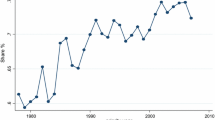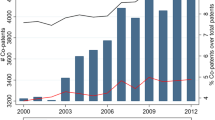Abstract
This study concerns the market for research collaboration between industry and universities. It presents an analysis of the population of all Italian university–industry collaborations that resulted in at least one international scientific publication between 2001 and 2003. Using spatial and bibliometric analysis relating to scientific output of university researchers, the study shows the importance of geographic proximity in companies’ choices of university partner. The analysis also reveals inefficiency in the market: in a large proportion of cases private companies could have chosen more qualified research partners in universities located closer to the place of business.

Similar content being viewed by others
Notes
The term “social proximity” is used in the sense given by Boschma (2005): “Social proximity is defined here in terms of embedded relations between agents at the micro-level. Relations between actors are socially embedded when they involve trust based on friendship, kinship and experience”.
After the introduction of academic privilege in 2001, a higher number of patents filed by academics themselves are certainly there, but relevant data are not readily available, which makes their identification really difficult.
For details see Abramo et al. (2008a).
For details see http://www.miur.it/atti/2000/alladm001004_01.
The discipline of Civil engineering and architecture was not included because the SCI™ does not provide full coverage of research output.
Unless otherwise specified, from this point on the term “company” includes the multiple locations of the same legal entity.
The number of university-company pairs is less than the number of university-company collaborations because, in the period considered, some pairs produced more than one collaboration (publication): certain pairs collaborated more than once. The same consideration will apply to the SDS-company level analysis as well.
In reality, each SDS includes multiple and probably non-quantifiable specializations that evolve in a dynamic manner. However, the authors retain that the approximation introduced by considering the SDS as a unique set of competencies, possessed by the participating researchers, permits the understanding of certain aspects of university-industry collaboration.
In this case the company is considered as a whole, not taking account of possible dispersed locations.
Geographic distance is expressed as the straight-line surface distance between partners, measured by means of coordinates of longitude and latitude.
Such distance, which refers to SDS-company pairs is slightly different from that reported in paragraph 5.3, which referred to university-company pairs.
For further information on the calculations and the precautions taken in the use of this indicator see Abramo et al. (2008b).
For further information on the calculations and precautions taken in the use of this indicator see Abramo et al. (2008b).
In the presence of more than one company, it is not possible to identify the “decision-maker”.
Where more than one university is involved in a university-industry collaboration grouping, the study conservatively considers the university with the highest position in the ranking for the SDS at stake.
For the analysis of the companies' choice of researchers, the study considers publications co-authored by a single private company (excluding more complex dynamics) and one or more universities. To further increase the reliability of the procedure, the analysis considers only the publications (1,400) by the 2,562 scientists that remained affiliated to the same university and the same SDS throughout the triennium under consideration, out of a total of a potential 2,966 university researchers.
On average, 90% of government funding (which represents 90% of the entire university budget) is required to cover employees’ salaries.
The 183 SDSs that we consider in our analysis is more than the number of Science Citation Index categories (168) in the same disciplines.
References
Abramo, G., D’Angelo, C. A., Di Costa, F., Solazzi, M. (2008a). University–industry collaboration: A bibliometric examination. Forthcoming in Technovation.
Abramo, G., D’Angelo, C. A., & Di Costa, F. (2008b). Assessment of sectorial aggregation distortion in research productivity measurements. Research Evaluation, 17(2), 111–121.
Antonelli, C. (2000). Collective knowledge communication and innovation: The evidence of technological districts. Regional Studies, 34(6), 535–547.
Arundel, A., & Geuna, A. (2004). Proximity and use of public science by innovative European firms. Economics of Innovation and New Technology, 13(6), 559–580.
Boschma, R. (2005). Proximity and innovation: A critical assessment. Regional Studies, 39(1), 61–74.
Cairncross, F. (1997). The death of distance: How the communications revolution will change our lives. London: Orion.
Cohen, W. M., Nelson, R. R., & Walsh, J. P. (2002). Links and impacts: The influence of public research on industrial R&D. Management Science, 48(1), 1–23.
EC-Commission of the European Communities COM 688 (1995). Green Paper on Innovation.
Glänzel, W., & Schubert, A. (2004). Analyzing scientific networks through co-authorship. In H. F. Moed, et al. (Eds.), Handbook of quantitative science and technology research (pp. 257–276). Dordrecht: Kluwer Academic Publishers.
Hallowell, E. (1999). The human moment at work. Harvard Business Review, 77(1), 58–65.
Handy, C. (1995). Trust and the virtual organization. Harvard Business Review, 73(3), 40–50.
Jaffe, A. B. (1989). Real effects of academic research. The American Economic Review, 79(5), 957–970.
Jaffe, A. B., Trajtenberg, M., & Henderson, R. (1993). Geographic localization of knowledge spillovers as evidenced by patient citations. The Quarterly Journal of Economics, 108(3), 577–598.
Katz, J. S. (1994). Geographic proximity and scientific collaboration. Scientometrics, 31(1), 31–43.
Katz, J. S., & Martin, B. R. (1997). What is research collaboration? Research Policy, 26(1), 1–18.
Lang, W. (2005). Knowledge Spillovers in different Dimensions of Proximity. Paper presented at the Regional Studies Association International Conference “Regional Growth Agendas”. 28th May to 31st May 2005 in Aalborg, Gateway 5 “Meaning and Role of Proximity”.
Laudel, G. (2001). What do we measure by co-authorships? Proceedings of the 8th International Conference on Scientometrics and Informetrics (Vol. 1, pp. 369–384). Sydney, Australia.
Lee, J., & Mansfield, E. (1996). The modern university: Contributor to modern innovation and recipient of industrial R&D support. Research Policy, 25(7), 1047–1058.
Lee, Y. S. (2000). The sustainability of university–industry research collaboration: An empirical assessment. Journal of Technology Transfer, 25(2), 111–133.
Lindelof, P., & Lofsten, H. (2004). Proximity as a resource base for competitive advantage: University–industry links for technology transfer. Journal of Technology Transfer, 29, 311–326.
Maggioni, M. A., & Uberti, T. E. (2007). Inter-regional knowledge flows in Europe: An econometric analysis. In K. Frenken (Ed.), Applied evolutionary economics and economic geography. Cheltenham: Edward Elgar.
Melin, G., & Persson, O. (1996). Studying research collaboration using co-authorships. Scientometrics, 36(3), 363–367.
Meyer-Krahmer, F., & Schmoch, U. (1998). Science-based technologies: University–industry interactions in four fields. Research Policy, 27(8), 835–851.
Moed, H. F., & Van Leeuwen, Th. N. (1996). Impact factors can mislead. Nature, 381, 186.
Olson, G. M., & Olson, J. S. (2000). Distance matters. Human–Computer Interaction, 15(2–3), 139–178.
Ponds, R., van Oor, F., & Frenken, K. (2007). The geographical and institutional proximity of research collaboration. Papers in Regional Science, 86(3), 423–443.
Prabhu, G. N. (1999). Implementing university–industry joint product innovation projects. Technovation, 19(8), 495–505.
Roberts, J. (2000). From know-how to show-how? Questioning the role of information and communication technologies in knowledge transfer. Technology Analysis & Strategic Management, 12(4), 429–443.
Shapiro, C., & Narian, H. (2002). Information rules: A strategic guide to the network economy. Boston: Harvard Business School Press.
Subramanyam, K. (1983). Bibliometric studies of research collaboration: A review. Journal of Information Science, 6(1), 33–38.
Townsend, A., DeMarie, S., & Hendrickson, A. (1998). Virtual teams: Technology and the workplace of the future. Academy of Management Executive, 12(3), 17–29.
VTR-CIVR. (2006). VTR 2001–2003. Risultati delle valutazioni dei Panel di Area. http://vtr2006.cineca.it. Accessed 16 June 2009.
Weingart, P. (2005). Impact of bibliometrics upon the science system: Inadvertent consequences? Scientometrics, 62(1), 117–131.
Author information
Authors and Affiliations
Corresponding author
Rights and permissions
About this article
Cite this article
Abramo, G., D’Angelo, C.A., Di Costa, F. et al. The role of information asymmetry in the market for university–industry research collaboration. J Technol Transf 36, 84–100 (2011). https://doi.org/10.1007/s10961-009-9131-5
Published:
Issue Date:
DOI: https://doi.org/10.1007/s10961-009-9131-5
Keywords
- University–industry collaboration
- Geographical proximity
- Information asymmetry
- Bibliometrics
- Co-authorship
- Italy




